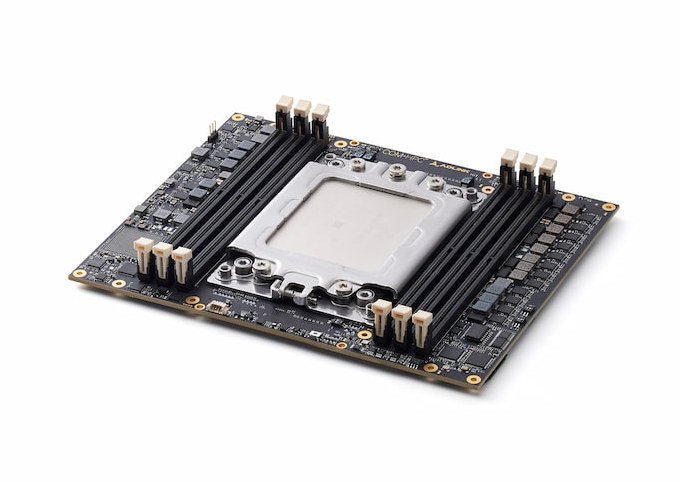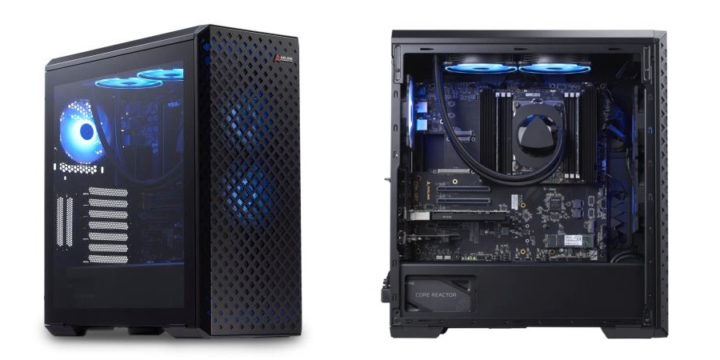ADLINK has integrated Ampere Altra, an up to 80-core Armv8.2 server processor with up to 175W TDP, into a COM-HPC module designed for embedded applications, together with the AVA Developer Platform equipped with a 32-core processor and housed in an “ultra-silent liquid-cooled tower system”.
Both the ADLINK COM-HPC Ampere Altra module and the developer kit are compliant with the just-announced Arm’s Scalable Open Architecture for Embedded Edge (SOAFEE), a “software initiative and reference implementation providing a cloud-native environment for embedded edge development”.
ADLINK COM-HPC Ampere Altra
 COM-HPC Ampere Altra key features and specifications:
COM-HPC Ampere Altra key features and specifications:
- SoC – Ampere Altra with 32x to 80x Armv8.2 Neoverse N1-based cores with up to 3.3 GHz frequency, up to 128 lanes of high-speed PCIe Gen4 and 8×72 ECC protected DDR4 3200 memory; TDP: 60 to 175 Watts depending on the number of cores
- System Memory – Up to 768GB DDR4 with 6x individual memory channels
- Networking – 4x 10GbE and 1x Gigabit Ethernet
- USB – 4x USB 3.0/2.0
- Expansion – 64x PCIe Gen4 lanes (3 x16 available)
- Dimensions – 200×160 mm (COM-HPC Size E)
The module complies with Arm SystemReady SR thanks in part to the edk2 bootloader with TianoCore/UEFI, and can run any stock Aarch64 OS including Ubuntu 20.04, CentOS, and images built with Yocto Linux.
If you wonder what kind of embedded applications may benefit from that much power, memory, and interfaces, ADLINK lists real-time/near-real-time applications including autonomous driving, stationery & mobile robotics, medical imaging and robotic surgery, test and measurement, and video broadcasting. The company also developed the “AVA-AP1”, a ruggedized vehicle prototyping platform with 80-core in collaboration with Arm and Ampere.
You’ll find limited “preliminary” information on the product page at this time. Availability is expected in Q4 2021, but pricing details are still TBD.
AVA Developer Platform
There’s been a quest to get a proper Arm workstation for native development for several years now, and the AVA Developer Platform gets added to the list with the following highlights:
- SoM – COM-HPC Ampere Altra module with 32x 64-bit Arm cores as described above, fitted with 32 GB DDR4 memory
- Storage – 128 GB NVMe M.2 SSD
- Mainboard- COM-HPC Server carrier (it should be that one)
- Networking – Intel Quad X710 10GbE LAN card
- USB – 4x USB 3.0/2.0 and 2x USB 3.0 [rear I/O], 2x USB 3.0 [front panel]
- Misc – Liquid cooling for silent, fanless operation
- Power Supply – 750 Watt power supply
- Dimensions – TBD (Tower enclosure)
As one would expect, software support is the same as for the SoM, and the AVA Developer Platform will be sold as an “Arm SystemReady SR-compliant SOAFEE reference development platform” designed for native arm64 development and compilation system for lower power embedded arm64 designs.
Again there are limited details on the product page, but I expect the price to be made public when the platform becomes available in Q4 2021, which may not be the case for the HPC-COM module.
What is SOAFEE?
We’ve written about Arm’s Scalable Open Architecture for Embedded Edge (SOAFEE) several times in this post, but what is it exactly? The press release only stated it was a “software initiative and reference implementation providing a cloud-native environment for embedded edge development”, but it appears to be specifically designed for the automotive industry as explained on Arm’s product page:
SOAFEE offers a cloud-native architecture enhanced for mixed-criticality automotive applications. It includes an open-source reference implementation to enable commercial and non-commercial offerings.
Building on Project Cassini and SystemReady standards, which define standard boot and security requirements for Arm architecture, SOAFEE adds the functional safety and real-time capabilities required for autonomous workloads.
Good, so it’s like some of Arm SystemReady to unify the booting process and hardware support, but with the addition of functional safety (FuSa) and real-time capabilities. I’d assume this can probably extend beyond automotive, and into robotics and medical equipment.
You’ll find out more in a white paper, while the open-source reference implementation will be made available on Gitlab.
Thanks to TLS for the tip.

Jean-Luc started CNX Software in 2010 as a part-time endeavor, before quitting his job as a software engineering manager, and starting to write daily news, and reviews full time later in 2011.
Support CNX Software! Donate via cryptocurrencies, become a Patron on Patreon, or purchase goods on Amazon or Aliexpress






The AVA one is *exactly* what I’ve been looking for for a while! If not too expensive, I’ll try to have one ordered for our lab.
there’s always the cloud, unless you were going to use it for a CI build farm for a couple dozen teams that will keep it busy 16+ hours a day… then you might actually get ahead with on-prem.
I occasionally use remote VMs in AWS but I find this really annoying. They’re particularly expensive for many cores so I’m very cautious to stop them after use, and I always need to go back to their interface first to log in, start them and wait for them to be ready. Also it’s not possible to test networking hardware inside a remote VM. I’m interested in testing 100G NICs there for example.
I’ve just read Marcin Juszkiewicz post about Tensorflow build times, and he’s using various hardware and an Oracle Cloud A1 instance with Ampere Altra with 16 cores. He says 16-core is the maximum in the free-tier.
I’m not sure how it’s possible, as last month the free-tier was limited to four cores. Maybe they’ve changed the limit.
4 cores was also my understanding. To be honest I’m not necessarily seeking something free, typically for build you need something fast but not often and you don’t care much about latency (i.e. you’re usually fine if you have to postpone access one hour or two). However for threaded application development you need instant undisturbed access and you also know that it’s not used often. That’s pure resource reservation for little use, which can only be overcome by constantly switching on/off. That’s where a local hardware machine is way more suitable.
They’ve finally figured out the proof-of-concept lab server. Now they just need to make an 4 or 8-core N2 developer workstation version with single/dual port and then get workstation GPU drivers working… so another what… 3-5 years before anyone wants to do productive full stack work from one of these platforms?
Oh I guess I shouldn’t forget Apple. They’re the cost-effective developer option. Pardon me for not going down that line of thinking earlier. It’s just so far outside their playbook for the last 20 years that anyone older than gen Z is going to have to shake their head fifty times to believe it, and still have reservations about trusting it lol.
In a Linux VM on such M1 thingies you get the following:
Impressive list of extensions!
175w tdp and they need liquid cooling? Not much more then an Intel 8core desktop
> 175w tdp and they need liquid cooling?
Better read again: ’60 to 175 Watts depending on the number of cores’. So with 32 cores it’s 60W TDP and with 80 cores it’s 175W. Also there’s no need for liquid cooling. It’s there for ‘silent, fanless operation’ which seems weird for an enclosure showing 5 large illuminated fans but most probably it will do the job dissipating the SoC’s heat efficiently away without a noisy small fan so the large and hopefully inaudible fans in the enclosure’s top will be sufficient.
The SOAFEE reference implementation can be found at:
https://gitlab.arm.com/soafee/working-groups/-/blob/main/groups/ecosystem/SOAFEE_reference/R1/index.md#embedded-workload-abstraction-and-orchestration-layer-ewaol
Jean-Luc,
would you by any luck have a working contact for the AVA platform ? Emails sent to the address mentioned on the site go to /dev/null, and filling their inquiry form on the site also goes slightly further, they send you a message confirming receipt of your message and only then they gently pass it to /dev/null. Thus in the end, two messages sent by different channels, zero response received 🙁
ADLink is an advertiser. I’ve just asked my contact about the best way to contact them about the AVA platform.
Great, thank you!
The price of the AVA Developer Platform just appeared on the site today! $5,450.00 Ouch! That’s totally unrealistic for a developer platform, I was hoping less than $2k 🙁 I wish them good luck.